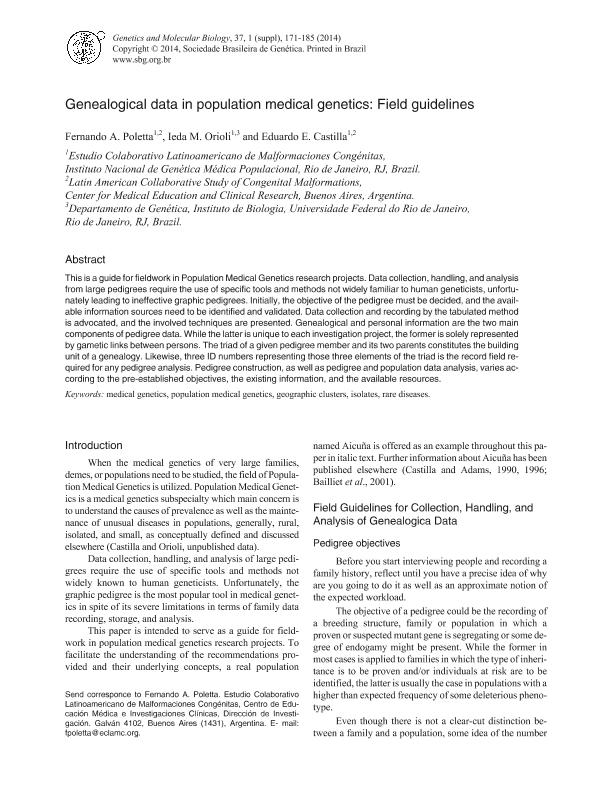Mostrar el registro sencillo del ítem
dc.contributor.author
Poletta, Fernando Adrián

dc.contributor.author
Orioli, Ieda M.
dc.contributor.author
Castilla, Eduardo Enrique

dc.date.available
2018-01-15T21:56:57Z
dc.date.issued
2014-03
dc.identifier.citation
Poletta, Fernando Adrián; Castilla, Eduardo Enrique; Orioli, Ieda M.; Genealogical data in population medical genetics: Field guidelines; Sociedade Brasileira de Genética; Genetics and Molecular Biology; 37; Supl. 1; 3-2014; 171-185
dc.identifier.issn
1415-4757
dc.identifier.uri
http://hdl.handle.net/11336/33375
dc.description.abstract
This is a guide for fieldwork in Population Medical Genetics research projects. Data collection, handling, and analysis from large pedigrees require the use of specific tools and methods not widely familiar to human geneticists, unfortunately leading to ineffective graphic pedigrees. Initially, the objective of the pedigree must be decided, and the available information sources need to be identified and validated. Data collection and recording by the tabulated method is advocated, and the involved techniques are presented. Genealogical and personal information are the two main components of pedigree data. While the latter is unique to each investigation project, the former is solely represented by gametic links between persons. The triad of a given pedigree member and its two parents constitutes the building unit of a genealogy. Likewise, three ID numbers representing those three elements of the triad is the record field required for any pedigree analysis. Pedigree construction, as well as pedigree and population data analysis, varies according to the pre-established objectives, the existing information, and the available resources.
dc.format
application/pdf
dc.language.iso
eng
dc.publisher
Sociedade Brasileira de Genética

dc.rights
info:eu-repo/semantics/openAccess
dc.rights.uri
https://creativecommons.org/licenses/by-nc/2.5/ar/
dc.subject
Medical Genetics
dc.subject
Population Medical Genetics
dc.subject
Geographic Clusters
dc.subject
Rare Diseases
dc.subject
Isolates
dc.subject.classification
Inmunología

dc.subject.classification
Medicina Básica

dc.subject.classification
CIENCIAS MÉDICAS Y DE LA SALUD

dc.title
Genealogical data in population medical genetics: Field guidelines
dc.type
info:eu-repo/semantics/article
dc.type
info:ar-repo/semantics/artículo
dc.type
info:eu-repo/semantics/publishedVersion
dc.date.updated
2018-01-11T13:49:04Z
dc.identifier.eissn
1678-4685
dc.journal.volume
37
dc.journal.number
Supl. 1
dc.journal.pagination
171-185
dc.journal.pais
Brasil

dc.description.fil
Fil: Poletta, Fernando Adrián. Consejo Nacional de Investigaciones Científicas y Técnicas; Argentina. Instituto Nacional de Genética Médica Populacional. Estudio Colaborativo Latinoamericano de Malformaciones Congénitas; Brasil. Consejo Nacional de Investigaciones Científicas y Técnicas. Oficina de Coordinación Administrativa Parque Centenario. CEMIC-CONICET. Centro de Educaciones Médicas e Investigaciones Clínicas "Norberto Quirno". CEMIC-CONICET.; Argentina
dc.description.fil
Fil: Orioli, Ieda M.. Universidade Federal do Rio de Janeiro; Brasil
dc.description.fil
Fil: Castilla, Eduardo Enrique. Instituto Nacional de Genética Médica Populacional. Estudio Colaborativo Latinoamericano de Malformaciones Congénitas; Brasil. Consejo Nacional de Investigaciones Científicas y Técnicas. Oficina de Coordinación Administrativa Parque Centenario. CEMIC-CONICET. Centro de Educaciones Médicas e Investigaciones Clínicas "Norberto Quirno". CEMIC-CONICET.; Argentina. Consejo Nacional de Investigaciones Científicas y Técnicas; Argentina
dc.journal.title
Genetics and Molecular Biology

dc.relation.alternativeid
info:eu-repo/semantics/altIdentifier/url/https://www.ncbi.nlm.nih.gov/pmc/articles/PMC3983591/
dc.relation.alternativeid
info:eu-repo/semantics/altIdentifier/url/http://ref.scielo.org/4vt2wj
dc.relation.alternativeid
info:eu-repo/semantics/altIdentifier/doi/http://dx.doi.org/10.1590/S1415-47572014000200004
Archivos asociados
